


Experiments with magnets and conductors
Aluminum Disk (an Eddy Current Brake)
Description:
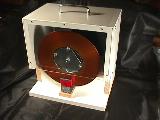
This is another example of Lenz's Law and Eddy currents, just like the Pendulum experiment. This time, instead of having the aluminum pendulum swing back and forth through the magnetic field set up between the two magnets, an aluminum disk is spun by a motor, and the magnets are moved into position. When this is done, the disk and motor are caused to slow down, like putting on a brake, but without touching the disk. Since this uses Eddy currents, it's called an Eddy Current Brake.
Construction: ![]()
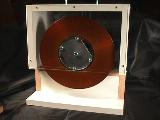
This experiment is made by mounting an aluminum disk to the shaft of an electric motor. The disk was purchased at a surplus store, and was the hard disk from an old computer drive. It measures 9" in diameter with a 4" hole in the middle and is about 0.090" thick. The brown coloring on the disk was, of course, the area where the disk had its tracks and sectors and stored the bits of information. It was mounted to an aluminum plate with four screws, and the plate was mounted to the shaft of the motor.
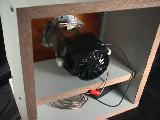
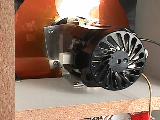
The motor is a universal motor, and operates at about 3600 rpm with 15Vac applied to it. The supply is a plug-in supply which is rated at 25W with 120Vac in. Its output rating is 19Vac at 0.84A. I measured about 21.9Vac at no load. With the motor spinning, it would measure 14.9Vac at 2.36A. When the magnets were present braking the motor, it would supply 15.3Vac at 2.60A. Since it wouldn't run for more than 3 to 4 minutes for the demonstration, the plug-in supply never gets hot. The motor is mounted to the inside shelf with two "L" brackets.
The box is made of pressboard shelving with a white melamine finish. This works real well and gives the unit a nice, clean look to it. A handle was added to the top of the box to make it easy to carry around.
Demonstration:
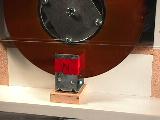
Begin by plugging in the power supply to start the motor spinning. After a few seconds, it will be up to speed. Then, slowly slide the pair of magnets into position so that the aluminum disk is in the gap between the North and South poles. Hang onto the magnets so they aren't pushed away! The disk will slow down to a crawl, and continue spinning, until you remove the magnets.
Conclusion:
As the aluminum disk spins through the magnetic field, eddy currents are induced within the disk, creating magnetic fields which oppose the relative motion of the disk to the magnets you are holding in position. This creates a braking force, slowing down the disk.
This principle is often used in industry to brake or stop a spinning motor, without requiring brake pads like on a car. Instead of a permanent magnet, though, an electromagnet is often used. With that, you can control the braking torque from zero to full with a simple control or dial.